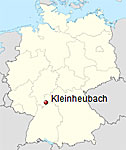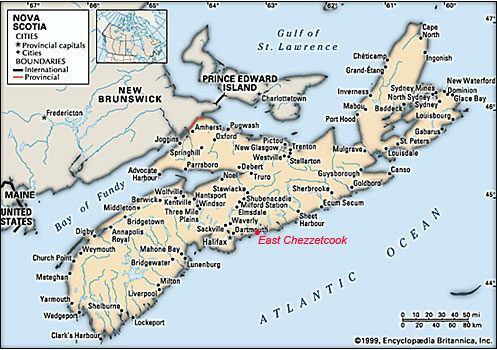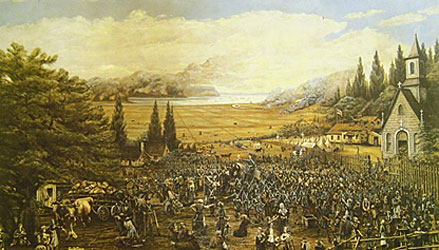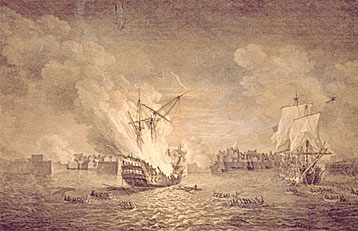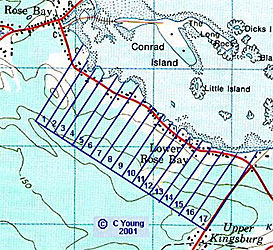JOHANN LORENTZ CONRAD (1701-1762) (Last Updated: September 09, 2012)
Kleinheubach, Germany, located on the south side of the
Lorentz CONRAD was born Nov 30, 1701 in Kleinheubach, Lowenstein-Werth, Bavaria, son of Anna Maria RENTZ & Burkhardt CONRADT JR (1670-1714). ** MORE ABOUT OUR CONRAD ANCESTORS IN GERMANY
Lorentz's mother, ANNA MARIA (nee RENTZ), died in childbirth in 1709 when Lorentz was only eight years old. Kunigunda APPEL becamehis father's second wife; his step-mother.
Lorentz marries Anna Salome WORTHER
On Jan 26, 1728 Lorentz (age 27) married in Germany to 19 yr old Anna Salome WORTHER, daughter of Susanna Katrina FERTIG & Hans George WORTHER (1676-1761), both from Kleinheubach.
Around 1735 daughter Anna married in Germany to Johann Wilhelm WENZEL (1705-1763). By 1751 Lorentz & Anna had seven living children, the youngest being Anna Margaretha (age 3).
The Conrad Exodus from Germany to Halifax
In 1751 England and France were preparing for war and Nova Scotia wanted settlers who would be loyal to the King. Because English settlers would not come, it was decided to settle Nova Scotia with Foreign Protestants who would not have allegiance to the French who were Catholic (Lorentz was a Lutheran). A proclamation was sent all over Germany. The German settlers who came saw this as an opportunity to become a land owner, taxes were high, they could escape religious persecution in Europe, and besides, there was talk of another war in their own homeland. The Crown hired John DICK in Rotterdam to recruit settlers for Nova Scotia.
On June 28, 1751, Lorentz and his family sailed from Rotterdam, Holland, aboard the ship Murdock. There were 100 families of Protestants; 298 sailed and after 83 days at sea 269 arrived at Halifax – 29 dead from scurvy.Although the passenger list indicated the CONRAD family as farmers, some of them had been skippers on the Main. Evidently they were familiar with boat building as well, since some of the grandsons of Lorentz later built schooners for themselves and their sons.
The patriarch of "those OTHER CONRAD families", JOHANN JACOB CONRAD b-1737, also arrived at Halifax in 1751, on the ship Pearl.
The Lunenburg settlers remained in Halifax for the next two years. The British kept them employed by building defences. In this way they paid for their passage.
In July of 1752 Lorentz and his family were one of those listed among the “Foreigners at the Block House and the Isthmus". In 1753 he was assigned a 30 acre Town Lot (Strasburger's Div F-10 & F-11).
The CONRAD family settles in Lunenburg
In 1853 an uneasy peace was made with the Micmac Indians and Governor Edward CORNWALLIS (1713-1776), who had been anxious to make another strong settlement of the coast, took advantage of this opportunity to do so. He moved almost all of the Germans to what is now called Lunenburg. ** MORE ABOUT EDWARD CORNWALLIS in Wikipedia ** MORE ABOUT EDWARD CORNWALLIS in DCBO
Before leaving Halifax, the settlers met at St Paul's Church to draw for lots (using a pack of cards). This church has the venerable distinction of being the oldest Protestant church in Canada.
On the morning of Tuesday, May 29, about half of the settlers began loading on the ships that were to take them to Lunenburg. The Nova Scotia Government had chartered most of the available ships down as far as New England to ferry settlers and their supplies. To minimize the number of ships required, the settlers were to be moved in two separate expeditions, about a week apart. The expeditions were to be accompanied by a small flotilla of British warships and a detachment of Rangers to provide assistance should the settlers encounter Indian or guerrilla resistance. Due to weather, they didn't escape the confines of Halifax Harbour until June 7.
The first of these settlers arrived in Lunenburg harbour on the morning of June 8, 1753. Colonel Charles LAWRENCE (1709-1760) first ordered the soldiers ashore to explore the woods to make certain no Indians were hiding there. The settlers were ordered to stay on board. He had good reasons for wanting defences built before landing the settlers, for there were real dangers of Indian attacks. However, after being held on the ships for over a week, some of the settlers became restless, in fact rebellious. LAWRENCE was only partially successful at holding them back. Two soldiers were killed in the woods. A 10 yr old boy, who had been sent on an errand by his father, was carried off by the Micmacs.
The settlers were disturbed by the crude conditions at Lunenburg. They had understood that they were to receive full homesteads immediately, in the form of a large plot of cleared land and a fully built and furnished farmhouse. Instead, they had nothing, they had to start from scratch, and they little time to plant gardens. When they first arrived at Lunenburg it rained nearly every day, food was scarce and they were wet, cold and hungry. The government stopped supplying food and few of the settlers had enough money to buy any, even if it were available. Few fields had been cleared so they couldn't grow enough to feed themselves. They learned to fish, and fish became a staple in their diet.
The first houses were built of six inch logs, about 6 feet high with thatched roofs. If they could find any, brick or stone was used to build chimneys, otherwise a mixture of straw and clay was used. Doors and shutters were built from thick planks, bolted together with iron for security.
In winter the rooms were heated by braisers. These were about a foot high and made of clay. Coals from the kitchen were added as the need arose. Until they learned to burn fish oil in a dish, the only source of light was from the kitchen fireplace. Eventually stoves and lamps became available.
Expulsion of the Acadians
Deportation of Acadians at Grand-Pre 1755
From Wikipedia: The Acadians and Mi'kmaq raided the Lunenburg settlement nine times over a three year period during the war. BOISHEBERT ordered the first Raid on Lunenburg (1756). Following the raid of 1756, in 1757, there was a raid on Lunenburg in which six people from the BRISSANG family were killed. The following year, March 1758, there was a raid on the Lunenburg Peninsula at the Northwest Range (present-day Blockhouse, NS)) when five people were killed from the OCHS and RODER families. By the end of May 1758, most of those on the Lunenburg Peninsula abandoned their farms and retreated to the protection of the fortifications around the town of Lunenburg, losing the season for sowing their grain. For those that did not leave their farms for the town, the number of raids intensified.
Seige of Louisbourg
Lorentz was 57 years old at the time of the historic Seige of Louisbourg. The long battle between France and England over the territory ended when Louisburg again fell to the British and was destroyed. The British now firmly controlled the province and because Acadians were no longer seen as a threat they were allowed to return. They joined the German settlers in the Lunenburg area of the south shore, while Ulstermen from Northern Ireland and New Hampshire settled in the Truro area. The Scots favoured the highlands of Cape Breton and Pictou, along the Northumberland Strait.
The Siege of Louisbourg 1758
Flora Otto: The expulsion of the Acadians from Grand Pre' in 1755 brought, some years later, the first permanent settlers, with the arrival in Grand Desert of John LaPIERRE, and later his brother Joseph and Felix WOLFE. The PETTIPAs and ROMAs came in the 1760's. The Acadians (LaPIERRE, WOLFE, and BELLEFONTAIN) were joined at the same time by the CRAWFORDs and other United Empire Loyalists. The English, Irish, and Scots (SMITH, FILLIS, LESLIE, FERGUSON) were among the first early settlers. Then came the German settlers from Lunenburg (CONROD, MISENER, NIEFORTH, GAETZ) and WEBBER and MYERS from Palantine, Germany, via South Carolina, as a result of the American Revolution (which brought the JULIEN, MAYATT, MORPHI, and ROMA families).
Final years at LaHave
In 1762 Lorentz CONRAD died in Lunenburg (LaHave) at the age of 61.
In 1784 George CONRAD (My ancestor; son of Lorentz) was given a land grant on Conrad Island
On Dec 12, 1787 Anna Maria Salome CONRAD died in LaHave at the age of 79.
Please post comments & queries at this link: ** FORUM DISCUSSING the LORENTZ CONRAD FAMILY
My own maternal ancestry descends from Lorentz as follows:
Anna WACHER & George CONRAD (1735-1809) ** MORE ABOUT ANDREW CONROD
========================= Family Details =========================
Children: ?1. 1720 ANNA MARIA CONRAD (m1. Johann Wilhelm WENZEL, m2. Johannes JUNG) 2. Dec 11, 1728 REBECCA ELIZABETH CONRAD (m. Johann Andreas JUNG JR) 3. Jun 24, 1732 JOHANN NICHOLAS CONRAD (m. Anna Catharine Barbara WALTER\WALTERS) 4. Jul 26, 1735 JOHANN GEORGE CONRAD (m. BARBARA WACHER\WACKER) ** My Maternal Ancestors ** 5. May 22, 1738 JOHANN CASPAR CONRAD (m. Caterina Frederika WOLF\WOLPH\WOLFE) 6. June 9, 1741 JOHANN LORENTZ CONRAD JR (m. Sophie Elizabeth SCHWARTZ) 7. Jan 3, 1745 GEORGE PHILIP CONRAD (Died in infancy Age 2) 8. Apr 7, 1748 ANNA MARGARETHA CONRAD (m. Johann Conrad WENZEL\WENTZEL)
|

